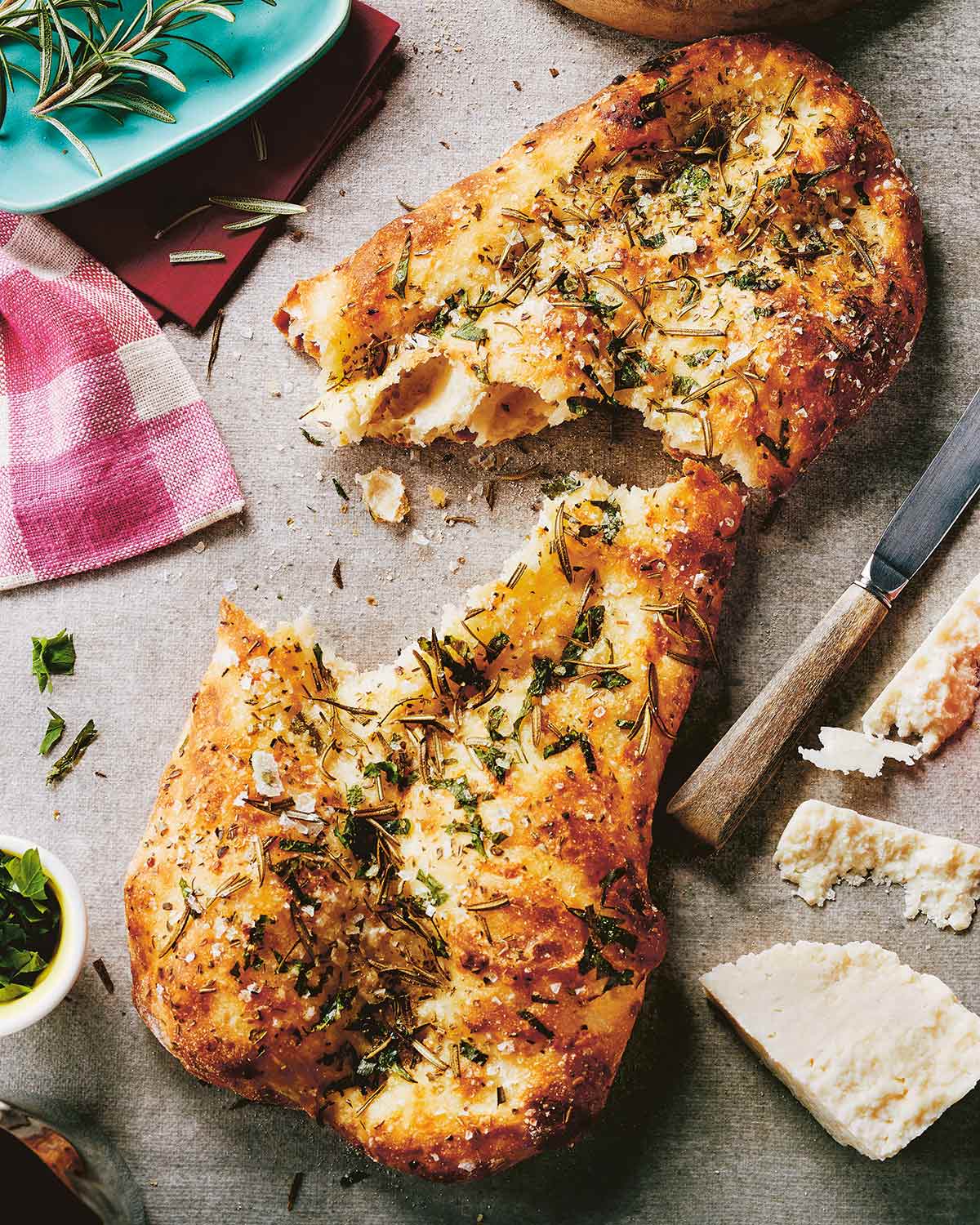
Located in Toronto’s Kensington Market, Blackbird Baking Co. is an artisan bakery where locals go to get fresh baguettes, buttery croissants, and signature sourdough loaves. At the helm of this neighborhood spot is chef-turned-artisan baker Simon Blackwell who shares his recipe for savory, herb-flecked focaccia bread.–Amy Rosen
Focaccia FAQs
Beyond just being cute as heck, dimples are important to the structure of focaccia. When you massage the dough, you’re working out the air and preventing the dough from rising too quickly. A well-proofed dough will have lots of air bubbles and rises quickly; that massaging adds dimples that keep your focaccia flat, as it should be. Also, those dimples hold the olive oil coating and help it soak into the dough, which gives your finished bread that crisp and golden crust.
This recipe suggests that you can, with one swift motion, slide your raw dough from a pizza peel onto a blazing hot pizza stone. It sounds difficult but it can be done–and practice will make it easier. However, if you’re too nervous for that kind of kitchen theatrics, you can simply assemble the focaccia on a piece of parchment and lift it directly onto the stone.
Focaccia dough will be doubled in size when it’s finished proofing. As well, you should be able to give it a poke with your finger to judge. The dough should spring back slowly, leaving a small visible indentation. If it springs back quickly, the dough isn’t ready and needs a little more time.
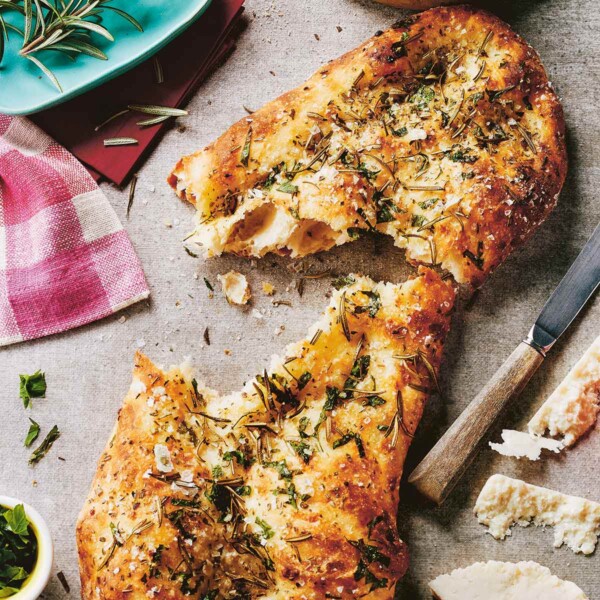
Focaccia
Ingredients
- 2 1/2 cups all-purpose flour, plus extra for dusting
- 1 teaspoon kosher salt
- 1 teaspoon granulated sugar
- 1/2 teaspoon instant yeast
- 3/4 cup grated pecorino Romano
- 1 1/2 cups water
- Olive oil
- Coarse sea salt
- 4 tablespoons chopped mixed fresh herbs, such as rosemary, parsley, and oregano
Instructions
- In a large bowl, combine flour, salt, sugar, yeast, and pecorino Romano. Stir well. Add water and mix by hand until combined, then continue to mix for 1 minute more. (The dough will be wet and sticky.)
- Lightly oil a large bowl, place dough in it, and cover. Let rest until the dough has more than doubled in size and is covered with bubbles, 10 to 12 hours.
- Generously dust a clean work surface with flour and use a bowl scraper (or rubber spatula) to scrape the dough out of the bowl in one piece. Using floured hands, gently fold the dough from the edges to the center to make a loose ball. Brush with olive oil and sprinkle sea salt over the surface. Cover and let rest until almost doubled in size, 1 1/2 to 2 hours.
- Preheat the oven to 450°F (232°C) and place a rack in the middle slot. Place a pizza stone or an upside-down baking sheet on the rack to warm.
- Meanwhile, generously dust a pizza peel or baking sheet with flour and place dough in the middle. Working quickly to prevent dough from sticking to the peel, use your fingers to dimple the dough in an outward motion, making it an even thickness across the peel. Continue dimpling until you have a 10-inch (25-cm) long oval-shaped loaf.
- Drizzle the dough with olive oil, top with chopped herbs, and sprinkle generously with sea salt.
- Shake the dough onto the baking stone and bake until the crust is a deep golden color, 15 to 20 minutes. Slide the focaccia onto a cooling rack and let sit for a few minutes before cutting.
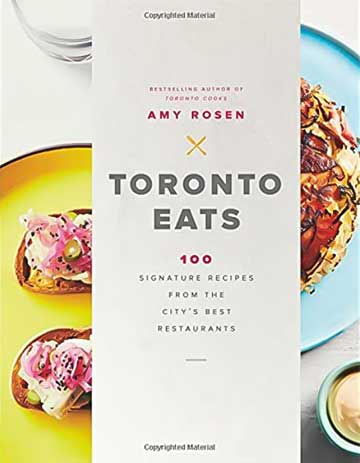
Explore More with AI
Nutrition
Nutrition information is automatically calculated, so should only be used as an approximation.
Want to Save This?
Recipe Testers’ Reviews
This gorgeous, flavorful focaccia comes together with a minimum of effort for maximum impact. Whereas many cheesy focaccia recipes would have you sprinkle the cheese on top, where it may harden or become an oily mess, here the pecorino is added together with the flour and yeast. I used a Microplane grater for finely shredded cheese which melted into the dough with little trace. The resulting flatbread has the funk of aged cheese baked into it, so it is wonderful with little accompaniment at all. When I make this again, I’ll press some roasted garlic cloves into the top of the dough — not because it needs them, but because I think it would go perfectly.
A note about the dough: it’s extremely sticky and wet, and never quite smooths out the way that you think it should after a proper rest. I think the texture is likely because of the large amount of cheese, and the moisture is what gives it so much lift when it bakes. I avoided the difficulty of moving the dough from the work surface to the peel, and from the peel to the oven, by doing the whole thing on a piece of parchment paper. I dumped the dough directly from the bowl where it did the overnight rise onto a piece of floured parchment, shaped it there, and left it to rise, covered by a large, overturned pot (again, to avoid sticking). I then dimpled the dough on that same piece of parchment and slid the whole thing onto the pizza stone.
I ate quite a bit of this warm for breakfast without anything to accompany it, and it was wonderful. If it lasts that long, I’ll have it later with some cheddar, some grilled sausage, and a salad.
Making any type of bread is a relationship, a commitment. Enter into it with optimistic caution. My relationship with this focaccia started with my morning coffee. Just me, my liquid motivation, and a sticky blob of dough. Our relationship had a bit of a rocky start, having to lace my fingers together over and over and over to free myself from the clingy dough. But I did. And as the day passed, it grew.
By early evening I was ready to work on the relationship again, and I was pleasantly surprised at how much my dough had matured. We formed a trust. It willingly eased itself out onto my cornmeal-dusted pizza peel. I dimpled my dough like I was giving it a terrible massage. I doused it with oil that pooled into the dimples like little craters filled with liquid gold. Then I blanketed my dimpled dough with herbs and salt. It slid right off the peel onto my hot stone, and I took the 20-minute leap of faith that everything would work out in the end. Spoiler alert, me and my focaccia lived happily ever after. It was crusty, salty, cheesy, herby, oily, amazing!
This was very different from any focaccia I’d made before, however, when I looked at the picture, it was identical, so I must have done something right! I was a little unsure whether this merited a Testers Choice, however, I put it out at the start of dinner and the entire loaf was gone by the end of the meal.
The recipe was fairly easy, with minimal hands-on time, and the resulting bread is chewy, with a crisp crust and nicely developed flavor. The dough was much too sticky to attempt sliding onto the pizza stone, so I stretched it on a baking sheet and placed that directly on top of my pizza stone.
Believe it or not, I’ve never made focaccia…not even during quarantine! But after making this inviting, herby, pecorino-infused recipe, I will be adding focaccia to my baking rotation for sure. This easy recipe a) makes your house smell like cheesy bread heaven and b) is seriously so simple. And guess what? Focaccia goes with EVERYTHING! So, this recipe’s basically essential.
This turned out a beautiful focaccia in my amateur opinion. We had it with hummus, olives, cheese, stuffed grape leaves, and other finger foods and it was great. I think you’d get 4-6 servings from this, depending on people’s hunger levels and ability to resist fresh, cheesy, herby flatbread.
My dough wasn’t so happy shaking from the pizza peel to the stone on my first attempt. My “amoeba” took about 30 minutes to bake and brown. Luckily for me (and my 10 guests), I sliced it and no one knew about my mistake! I’ve had this issue making pizza before and have resolved it by using cornmeal as a ball bearing of sorts which works magically each time.
After consulting my Italian friends, they recommended that I use a cast-iron pan so as to get the nice crisp bottom on the bread but avoid the transfer. This was FANTASTIC (both in taste and technique). I pre-heated the oven with two 9″ cast-iron pans during the second rise which I did on a cutting board with the loaf split into two. After their 80-minute rise, they’d doubled in size so I lightly scooped them up with floured hands using the Saran Wrap that I’d used to cover them and put them directly into the hot and olive oiled pans using my fingers to carefully spread the dough toward the edges of the pan.
This was a total winner and I’ll be making it again and again! It was delicious served alone and with vegetable crudités, hummus, and olives.
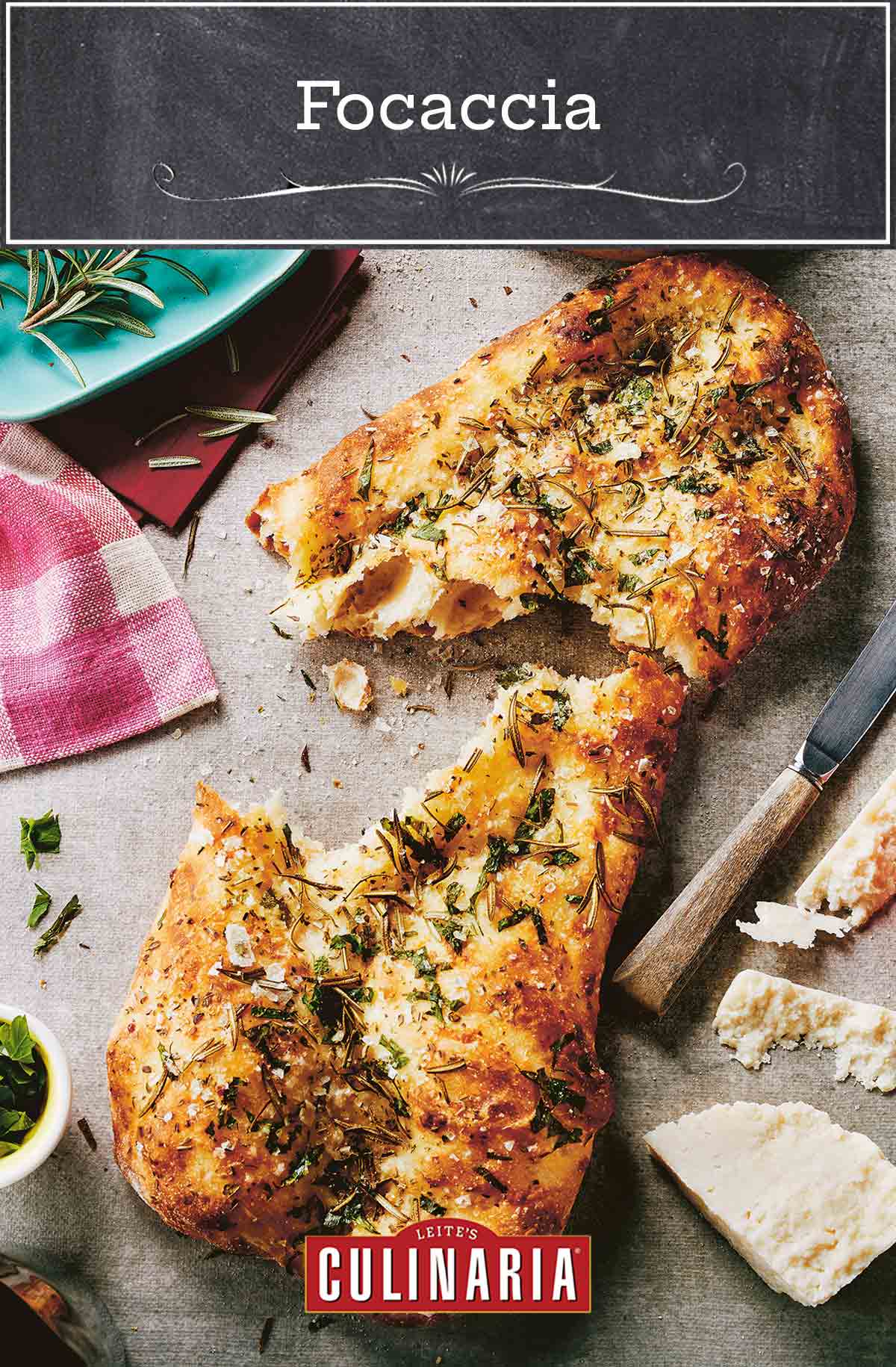
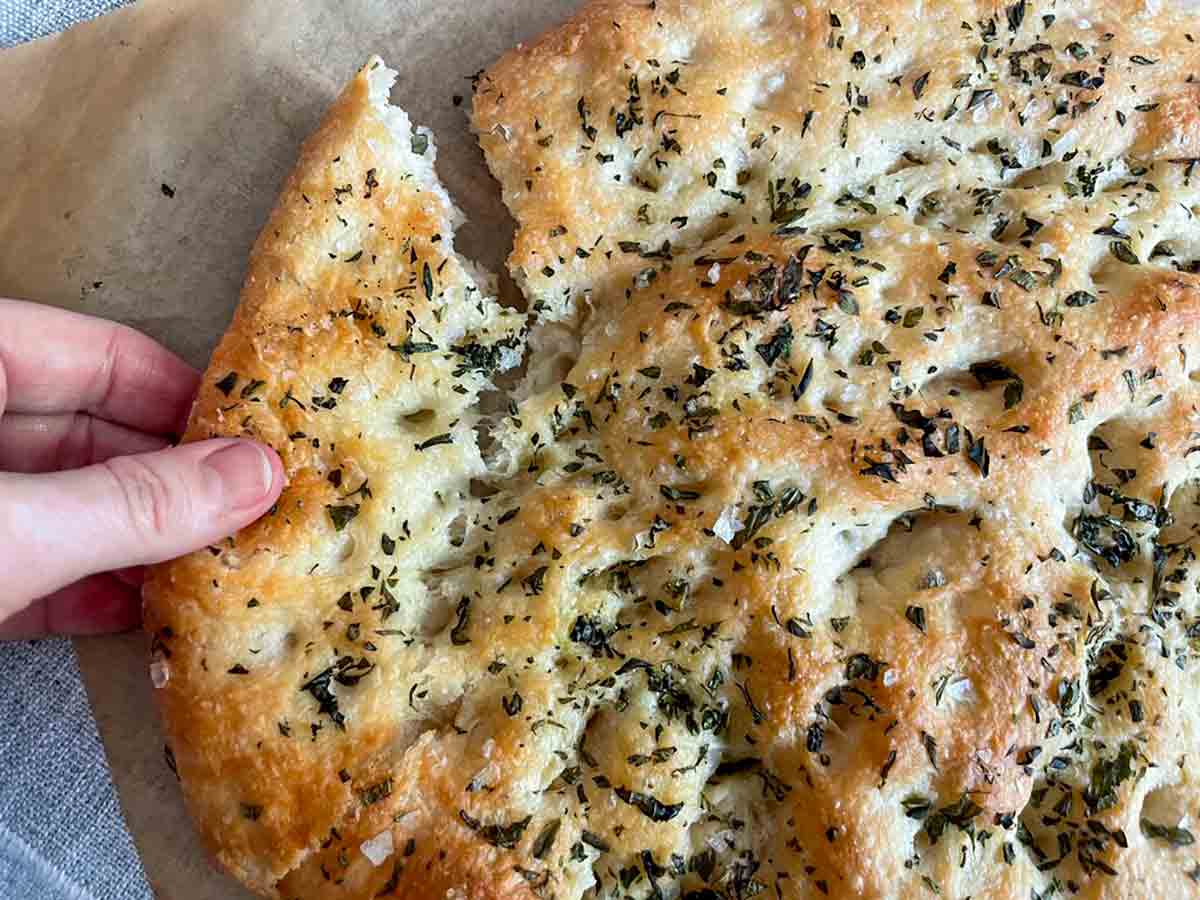













Hey, the metric quantities do not correspond to the US values. Maybe you should adjust that.
Adrian, which ingredients are you referring to?
Water-to-flour ratio seems to be wrong. I think 1.5 cups of water should not equal to 355ml or do they? Because my dough was way too wet.
To be precise, the US flour to water ratio is 1.6:1, the metric ratio is 0.95:1 by weight.
Adrian, the water conversion is correct. 1.5 cups of water is 355 ml, and you can’t compare the ratios because they convert on different scales. This is a very wet dough, so it sounds like you were making it correctly.